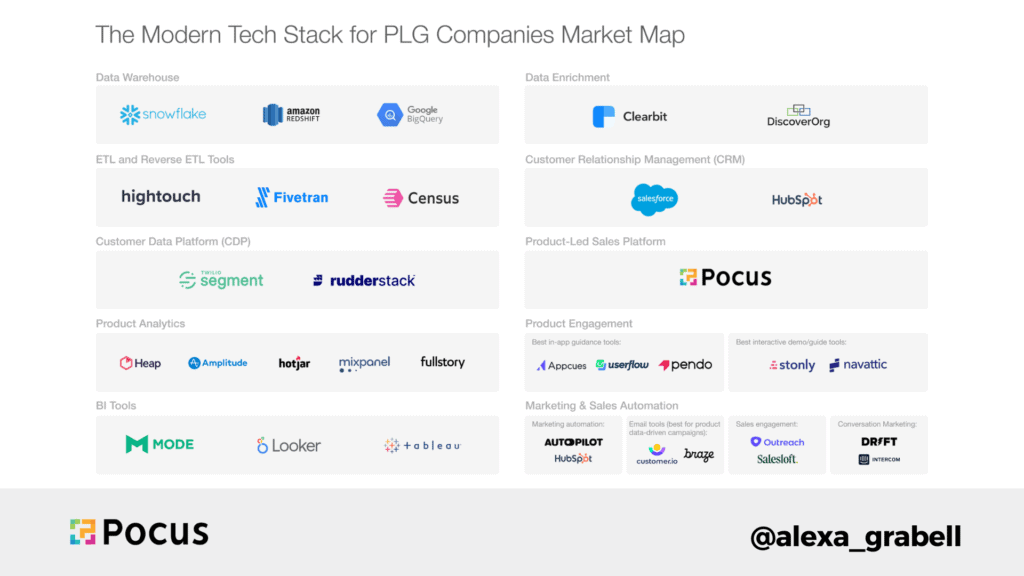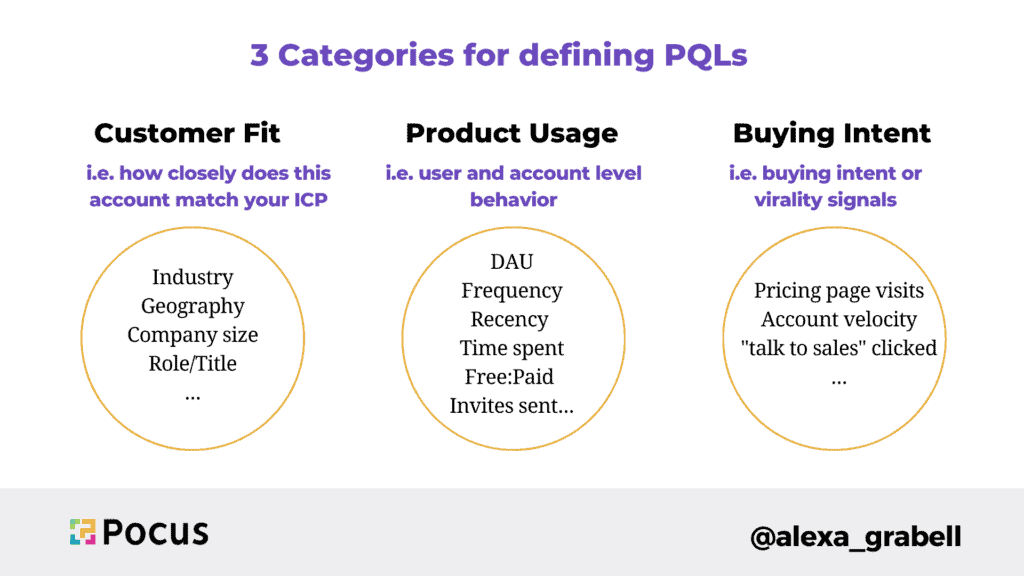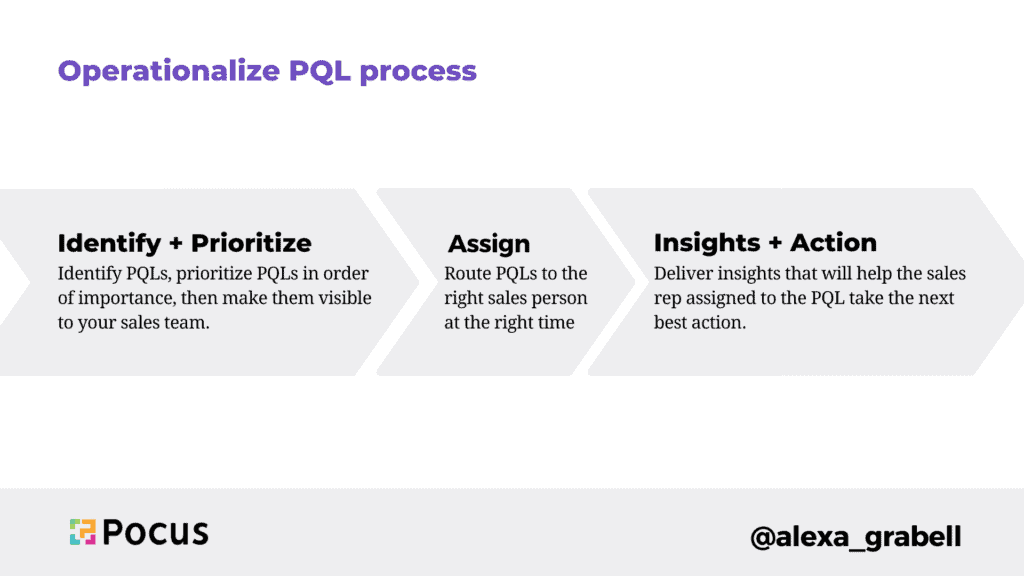The fastest-growing product-led growth (PLG) companies have discovered the secret to revenue acceleration: sales teams.
PLG companies are in a great position to layer a sales team on top of their product-led model. The healthy self-serve flywheel paves an incredible foundation for sales growth. By filling a sales funnel with self-serve users–many of which are champions that love your product – your company has built the runway for liftoff!
But, it’s not that easy…implementing a product-led sales (PLS) motion is a cross-functional initiative that requires new cultural norms, sales enablement processes, and technologies. In this article, we’ll walk you through what PLS is, why you should care about PLS, and the 5 steps to implement it.
Product-Led Sales 101
Pocus defines product-led sales as an end-user-focused sales model that leverages self-serve users as the primary funnel for sales teams.
Product-led sales is all about understanding how users are engaging with the product to inform who the product champions are, when the sales team should engage, and what the next best action is. Because of this, sales reps are able to identify, prioritize, and understand product-qualified leads (PQLs) in order to convert self-serve users into high lifetime value customers.
For many PLG companies, implementing sales often defaults to the traditional enterprise sales model. The allure of familiar playbooks, well-trained account executives, and a pretty simple process is difficult to deny. However, this traditional methodology simply doesn’t cut it in the new product-led world for a few reasons.
- In traditional enterprise sales, sales reps chase cold leads, work top-down, and ultimately push a hard sell. This is inefficient and frustrating for sales reps - they are essentially throwing pasta at a wall to see what sticks despite sitting on a goldmine of self-serve users.
- Users don’t want to be sold. It’s an unpleasant experience for users who are not yet ready to talk to sales. Users don’t want to talk to sales...until they need to talk to sales.
- It’s not a cost-effective model for the company. When the sales team is only chasing outbound deals, they leave money on the table by not considering expansion revenue from self-serve users.
Product-led sales unlock growth where old-school sales cannot. By focusing on qualified leads and value-driven selling, sales reps can successfully convert self-serve users to high-value customers. The benefits include:
- Improved customer experience
- Decreased customer acquisition cost (CAC)
- Accelerated time to revenue (velocity)
- Higher annual contract value (ACV)
The 5 Steps to Implement Product-Led Sales
#1. Create a healthy self-serve flywheel
This might sound obvious, but before you layer on a sales motion, your self-serve flywheel must be up and running to generate a funnel of PQLs for your sales teams. Sales teams at PLG companies are more data-driven, customer-centric, and focused on adding value (rather than making quotas). These sales reps are only engaging with users with the highest propensity to buy; thus, they must feel comfortable digging through some data to inform their outreach.
Sales teams do not own this step–instead, marketing, product, growth, etc. teams must make it easy for users to get started and experience value without talking to a human. For the purpose of this post, we won’t focus on how to do this, but what you should be aware of is when you know the self-serve flywheel is working well enough to hire a sales team.
There are many ways to determine when to add a salesperson to the PLG motion, but we recommend looking out for:
- An increase in “sales-y” requests or “hand-raisers.” A.K.A users start wanting to talk to a human because they have more questions and needs. Instead of fielding questions like, “how do I reset my password?” the requests become more aligned with, “how do I deploy the product for 1,000 people?” or “can you help me centralize billing across various teams?”
- Customer-facing teams start “acting” like sales. Your current (non-sales) team is already starting to work directly with individual customers in new ways. In many situations, your employees in growth, marketing, or support will naturally expand their responsibilities in order to help the customer on their journey from onboarding successfully to committing to a broader, more complex deployment.
#2. Get cross-functional buy-in
This is arguably the most important step. It can take a while to get buy-in, so it’s important to spend the time up-front, develop the business case, and regularly get buy-in. You need to get the right people aligned, given that PLS is a cross-functional strategy.
You should outline a 1-page strategy doc or business case for PLS. The goal of this 1-pager is to set expectations, ensure there is clear communication across the organization, remove any silos between sales and self-serve, and establish a framework for experimentation.
This one-pager can be formatted like so…
#3. Define & operationalize your PQLs
This is the step where most folks get nervous about and want to throw in the towel. But, it doesn’t need to be complicated. We’ll break this down into 3 digestible steps.
1. Level up your PLG tech stack
Ensure you are collecting the data you want (and need) to execute on PLS. This means...
- Storing product usage data in the data warehouse and/or your data platform (CDP).
- Making sure your CRM has the data you need to segment your customers by fit (i.e., size, location, geography).
- If you don’t have the data above, consider a data enrichment tool like Clearbit.

(You can find more SaaS tools here.)
2. Define your PQLs
Look at your existing self-serve user base and choose the signals that matter for the following categories: customer fit, product usage, and buying intent.

Check out this post to learn more about defining PQL's.
3. Operationalize PQLs

- Identify & prioritize: You can do this in your existing tools by combining product usage data and CRM data to create scoring that identifies a PQL. Or, you could use Pocus to enable sales teams with product usage & CRM data in one place so they can identify, prioritize, and understand their top accounts and users.
- Assign to reps: Routing PQLs to the right sales rep at the right time can be a challenging process. Many companies will begin with a small group of sales reps and manually execute this process in Salesforce. This is another area where Pocus can help. Sales reps can configure Slack alerts when accounts hit a particular threshold. They can also access views configured to their territory or accounts where they are the account owner.
- Insights & Action: After interviewing hundreds of PLG practitioners (and in particular some of the very best PLG companies with a sales team), one thing became clear–you need to explain why an account is a PQL and ready for sales. Without the why it’s much harder for a sales rep to effectively action this information. With Pocus, sales reps have the ability to see why an account is product-qualified and provide deep insights to help sales reps action that information. Examples include: who is the most engaged user in the account, who are the product champions, and more.
#4. Hire your PLS team
Now that you’ve done steps 1-3, you can finally hire and/or upskill a product-led sales rep. This is easier said than done – your PLS team looks and acts differently than an enterprise sales team.
If you’re hiring your first PLS rep, we recommend hiring a generalist who is comfortable digging into data and can be flexible based on the evolving company needs. They are experimental and collaborative and can do a little bit of everything. Your first hire will depend on your company goals and stage…
- Do you need help converting self-serve users to paid customers → Account Executive (AE)
- Do you need help guiding users on their journey to realize value? → Sales-assist
- Do you need help managing inbound and mining PQLs for outbound? → Sales or Business Development Rep (SDR or BDR)
Here’s the full PLS squad for an established company:
- AE: Receives PQLs from SDR/BDRs and the sales-assist team to help the customer navigate from self-serve users to an enterprise customer while continuously finding new opportunities to expand.
- Sales-assist: Help customers adopt the product and resolve friction to accelerate self-serve signup flows, surface new sales opportunities, and capture feedback to route back to product/marketing. The sales-assist team is solution selling–a.k.a helping, not selling–to educate the customer and help them move to the next milestone.
- SDR/BDR: Manager inbound from hand-raisers and mine PQLs for outbound.
#5. Define your PLS motion
Now that you’ve done steps 1-4, you can finally create the internal PLS playbook! Revisit the 1-pager that you created in step 2 as a starting point. Now, you can test, iterate, and disseminate information across the org. We recommend this in three phases:
Phase 1: Create a new 1-pager draft with the original cross-functional team
Phase 2: Test roll out the new process with a handful of sales reps. Collect feedback, test, & iterate.
Phase 3: Roll out to the entire company, which involves:
- Kick-offs and education sessions
- Sales enablement
- Monthly/quarterly trainings
Make sure to be very clear on the hand-offs and routing between self-serve and sales. Your goal is to harmonize the two processes so that sales teams understand what they own, who they work with, and how they should sell. The rest of the organization understands this as well, so there should be no silos, only streamlined processes.
Closing thoughts
To wrap it up:
- Don't overcomplicate this; you just need to find a way to get your best-fit users into the hands of a sales team when they are ready.
- Always ship, test, and iterate.
- Be clear with expectations (to leadership and your sales teams).





